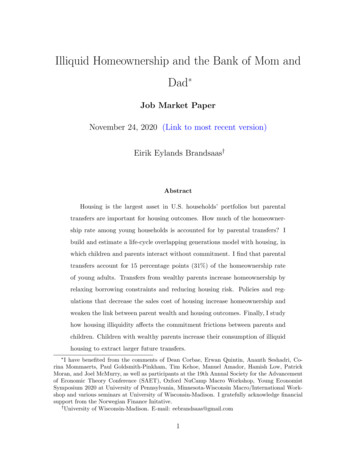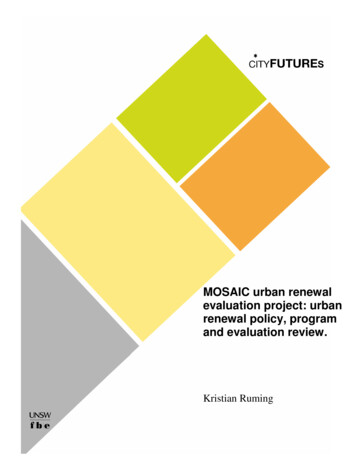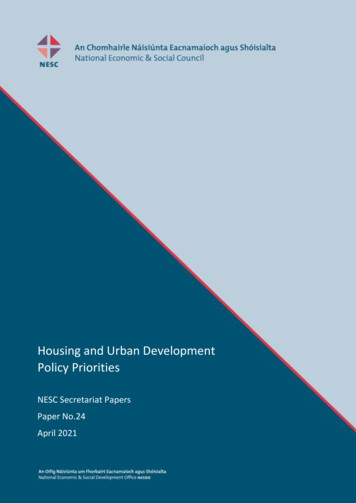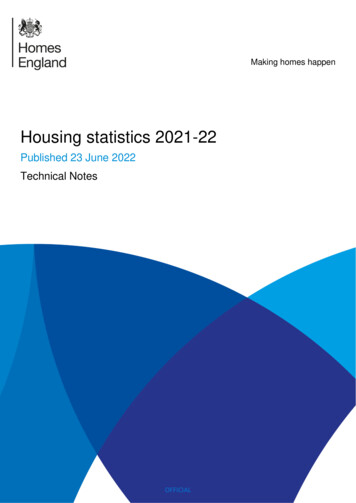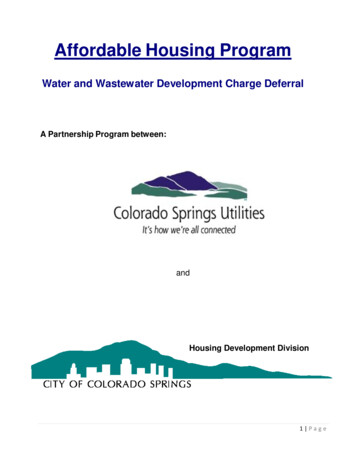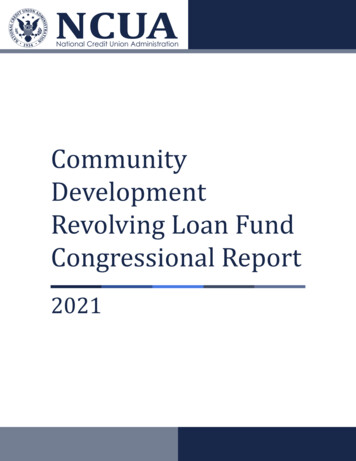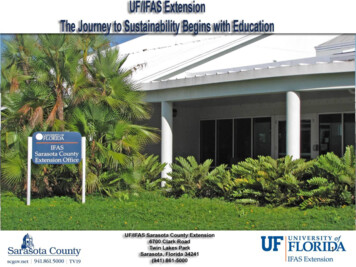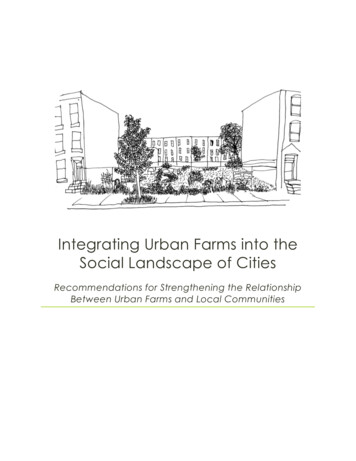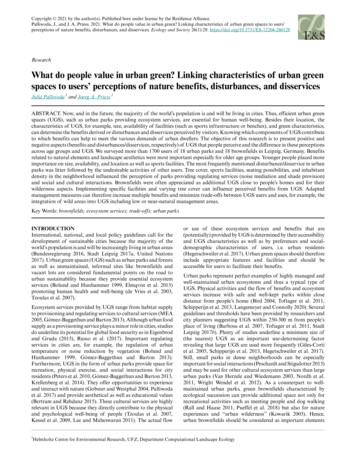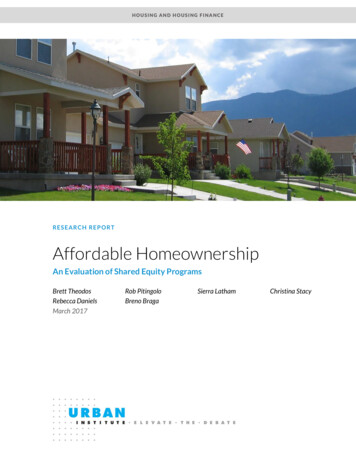
Transcription
HOUSING AND HOUSING FINANCERE S E AR CH RE P O R TAffordable HomeownershipAn Evaluation of Shared Equity ProgramsBrett TheodosRebecca DanielsMarch 2017Rob PitingoloBreno BragaSierra LathamChristina Stacy
AB O U T T HE U R BA N I NS T I T U TEThe nonprofit Urban Institute is dedicated to elevating the debate on social and economic policy. For nearly fivedecades, Urban scholars have conducted research and offered evidence-based solutions that improve lives andstrengthen communities across a rapidly urbanizing world. Their objective research helps expand opportunities forall, reduce hardship among the most vulnerable, and strengthen the effectiveness of the public sector.Copyright March 2017. Urban Institute. Permission is granted for reproduction of this file, with attribution to theUrban Institute. Cover image by from Mountainlands Community Housing Trust.
AB O U T CA PI T AL I MP AC T P A R TNE RSCapital Impact Partners transforms underserved communities into strong, vibrant places of opportunity. A leadingnonprofit Community Development Financial Institution, Capital Impact Partners delivers strategic financing,incubate social innovation programs and support capacity building and policy reforms that create social change anddeliver financial impact nationwide. Over a 30-year history, Capital Impact Partners has disbursed more than 2billion to help ensure access to quality health care and education, healthy foods, affordable housing, cooperativedevelopment, and the ability to age independently.AB O U T G R O UN DE D S OL U T I ONS NE TW O R KGrounded Solutions Network works nationally, connecting local experts with the networks, knowledge and supportthey need to build inclusive communities. Grounded Solutions Network helps promote housing solutions that willstay affordable for generations so communities can stabilize and strengthen their foundation, for good. GroundedSolutions Network was formed by the integration of the National Community Land Trust Network andCornerstone Partnership (formerly a program of Capital Impact Partners) to better support their members, fundersand partners to build and preserve communities where everyone can live.AB O U T T HE S OC IA L I NN OV A TI ON F UN DThe Social Innovation Fund (SIF) is a program of the Corporation for National and Community Service, a federalagency that engages millions of Americans in service through its AmeriCorps, Senior Corps, and VolunteerGeneration Fund programs, and leads the nation’s volunteer and service efforts. The SIF positions the federalgovernment to be a catalyst for impact—using public and private resources to find and grow community-basednonprofits with evidence of results. The SIF focuses on overcoming challenges confronting low-income Americansin three areas of priority need: economic opportunity, healthy futures, and youth development. To learn more, visitwww.nationalservice.gov/sif.AB O U T T HE F O R D F O UN D A T I ONThe Ford Foundation is an independent, nonprofit grant-making organization. For more than 75 years it hasworked with courageous people on the frontlines of social change worldwide, guided by its mission to strengthendemocratic values, reduce poverty and injustice, promote international cooperation, and advance humanachievement.
ContentsAcknowledgmentsviExecutive SummaryviiStudy Design and Program ApplicantsviiShared Equity Home PurchasesviiiShared Equity Buyer OutcomesviiiImplications for Policy and PracticeChapter 1. Introduction and Backgroundix1Background2Shared Equity Homeownership3The Cornerstone Homeownership Innovation Program5Research Approach6Chapter 2. Shared Equity Program Models8Overview of Shared Equity Program Model Components8Establishing and Maintaining Affordability over Time9Participant Engagement11Lender Engagement12Marketing to Potential Buyers12Shared Equity Program Profiles13HomeBase Texas (Austin, Texas)13Hello Housing (San Francisco Bay Area, California)13Champlain Housing Trust (Burlington, Vermont)14Long Island Housing Partnership (Long Island, New York)15The Housing Fund (Nashville, Tennessee)15Mountainlands Community Housing Trust (Park City, Utah)16Homestead Community Land Trust (Seattle, Washington)17South Florida Consortium (South Florida)17City First Homes (Washington, District of Columbia)18Chapter 3. Data and MethodologyData2020Application Data20Homekeeper Administrative Data on Shared Equity Purchase Transactions21Baseline and Follow-up Credit Bureau Data21Secondary Data22Empirical Methodology22
Program Applicants22Shared Equity Purchases22Shared Equity Buyer Outcomes23Chapter 4. Program Applicants28Demographics29Education and Employment30Finances and Creditworthiness31Neighborhood Characteristics34Chapter 5. Shared Equity Home Purchases35Home Purchasers36Shared Equity Transactions40Chapter 6. Shared Equity Buyer Outcomes45Shared Equity Purchasers versus All Other Applicants45Shared Equity Purchasers versus Other Applicant Purchasers48Shared Equity Purchasers versus Other Credit Bureau Purchasers51Chapter 7. Implications for Practice and Policy56Future Research57A Growing Field58Appendix A. Codebook60Appendix B. Baseline Medians by Purchase Status63Appendix C. Minimum Detectable Effects64Appendix D. Regional Demographic Characteristics, by Site67Notes69References71About the Authors73Statement of Independence74CONTENTSV
AcknowledgmentsThis report was funded by Capital Impact Partners, with support from the Social Innovation Fund, theFord Foundation, and the Annie E. Casey Foundation. We are grateful to them and to all our funders,who make it possible for Urban to advance its mission.The views expressed are those of the authors and should not be attributed to the Urban Institute,its trustees, or its funders. Funders do not determine research findings or the insights andrecommendations of Urban experts. Further information on the Urban Institute’s funding principles isavailable at www.urban.org/support.This report was supported and managed by Grounded Solutions Network. We thank the GroundedSolutions staff who contributed to the development of this report by providing feedback, expertise, andresearch support: Tiffany Eng, Elizabeth Haney, Jenee Kresge Gaynor, Hong Ly, Rachel Silver, and EmilyThaden. We also thank Thane Maxwell and Rick Jacobus, independent consultants. A tremendous thankyou to the staff and applicants at the shared equity programs for their support of the evaluation. Andfinally, thanks to Ellen Seidman and Douglas Wissoker for serving as technical reviewers for this report.We also add a special mention to Ken Temkin, a coauthor on the baseline report for this study, andesteemed colleague who contributed substantively to this research and will be greatly missed.VIACKNOWLEDGMENTS
Executive SummaryOwning a home has long been a meaningful milestone in many Americans’ lives. Yet, because homeprices continue to rise during the current economic recovery and since lending standards remain tightby historical standards, many renters view homeownership as an unattainable goal. Shared equity is ahomeownership model that allows income-eligible families to purchase homes at below-market prices.In return for the subsidized purchase price, the owner’s potential capital gains from home resale arerestricted.With the support of the Social Innovation Fund and the Ford Foundation, Capital Impactestablished the Cornerstone Homeownership Innovation Partnership (CHIP) in 2011. CHIP identifiesand supports a set of leading nonprofit stewards of long-term affordable homeownership units, andhelps build the evidence base around shared equity. Capital Impact commissioned the Urban Instituteto evaluate housing outcomes for buyers under CHIP.To date, there has been little empirical research on shared equity homeownership that evaluatesresults for homeowners. This study helps bridge this gap by examining the CHIP grantees, allowing us toexplore what types of households they enable to buy homes, as well as financial and neighborhoodoutcomes.Study Design and Program ApplicantsIn this study, we evaluated 9 shared equity programs made up of 683 people who applied to theprograms and consented to participate in the research between June 2012 and June 2014. Theprograms are located in Austin, Texas; the Bay Area in California; Burlington, Vermont; Long Island,New York; Nashville, Tennessee; Park City, Utah; Seattle, Washington; South Florida (Broward andPalm Beach Counties); and Washington, DC. From intake application data, we learned that applicantsshare the following characteristics: An overwhelming share of applicants (96 percent) were not homeowners at the time ofapplication, a requirement for many programs. Half of applicants had a bachelor’s degree and roughly one-fifth had an associate’s degree.These education levels were higher than for the overall US population.EXECUTIVE SUMMARYVII
However, applicants had incomes that were on average 51 percent of their area’s medianfamily incomes—far lower than for many homeownership supports, which often target familiesat or above 80 percent of area incomes. Nearly half of all applicants were housing costburdened, defined as spending more than 30 percent of their income on housing and utilityexpenses. Applicants had little net worth at the median, 712, but their credit scores were “good,” with amedian of 696.Shared Equity Home PurchasesMany applicants in this study’s sample purchased a shared equity home (36 percent). Some applicantswho did not purchase through shared equity also purchased homes; about one-third of applicants whodid not purchase a shared equity home (and 20 percent of all applicants) opted to purchase a homewithout participating in a CHIP program. The remaining 44 percent of applicants did not purchase ahome during the study period.At baseline, applicants who purchased a shared equity home during the study looked comparable to“other” purchasers who bought apart from the programs. Shared equity purchasers tended to be betteroff financially at baseline than those who did not purchase a home, however. For example, they wereless likely to have nonmortgage delinquencies, accounts in collections, or past foreclosures. Their creditscores were higher and they had roughly twice as much saved for a home purchase.Those who bought a home through a shared equity program received, relative to the unsubsidizedmarket price of their home, on average the equivalent of 39 percent of its value in subsidies. Theaverage unrestricted market value of purchased shared equity homes was roughly 241,000, with over 94,000 in subsidy. Borrowers contributed down payments worth an average of roughly 11,000 (5percent of the unrestricted market value) and the remaining balance was financed by buyers (onaverage, approximately 138,000 and 57 percent of the unrestricted market value).Shared Equity Buyer OutcomesUsing credit bureau data, we compared applicants who purchased a shared equity home with applicantswho did not purchase a shared equity home. We also compared applicants who purchased a sharedVIIIEXECUTIVE SUMMARY
equity home with the subset of applicants who purchased “other” non–shared equity homes. We madethese comparisons at two different times: before the potential buyer applied to the program (June 2012or June 2013) and at follow-up (June 2016). Finally, we also compared outcomes between shared equitybuyers and a comparison group of nonapplicants who purchased a home during the study period, alsousing credit bureau data.We found that shared purchasers had smaller mortgages than other applicant purchasers and thatthey had lower monthly payments on all credit accounts. There were no other differences innonmortgage, mortgage, or neighborhood outcomes when comparing shared equity buyers to otherapplicants, or the subset of other applicants that purchased homes outside of the shared equityprograms. When comparing shared equity purchasers to nonapplicant purchasers with similarobservable characteristics, we again found that shared equity purchasers had smaller mortgages andhad smaller monthly payments on all credit accounts. We also saw that they were less likely to havehome equity lines of credit, and had higher accounts in collections. All these results were robust toadjustments accounting for tests of multiple outcomes. After making such adjustments, we did not seedifferences in other financial and neighborhood metrics. Apart from accessing smaller mortgages, moretime may be needed to understand whether and how shared equity purchasers are better or worse offfinancially compared with other buyers.Implications for Policy and PracticeMany applicants in this study’s sample were able to buy shared equity homes, the average subsidies forthe shared equity homes were sizeable, and shared equity buyers had incomes at baseline well belowarea medians. Together, these facts indicate that shared equity programs were serving their coremission of linking low- and moderate-income people with affordable owner-occupied housing.A fairly high share of those who did not buy a shared equity home ended up purchasing a homeoutside the programs. This may be appropriate sorting: people who do not need all the help sharedequity gives should not accept it, because they would be trading a sizable portion of the upside of theirinvestment. The remainder of applicants who did not buy any home were no longer interested inpurchasing a home or were not able to buy. It may be that some applicants would have benefited fromgreater help, for example, through financial coaching (Theodos, Simms et al. 2015).Assessing the impacts of homeownership can be a challenging endeavor because randomization israrely possible and a high degree of personal choice is involved in the decision to buy a home. However,EXECUTIVE SUMMARYIX
by combining all of these comparisons groups into one study and using a robust set of baseline controls,we have tested for links between shared equity programs and buyer outcomes.Some important questions remain unanswered by this research, and warrant further study. Mostimportant in our minds is whether the benefits of reduced mortgage costs redound in meaningful waysto owners over time. It is possible that these buyers will subsequently differentiate themselves fromother buyers in their levels savings, debt, financial stress, and mortgage delinquency and foreclosure.This study was only able to observe buyers through June 2016; longer-term follow-ups would be useful.Further, neighborhood outcomes also merit further investigation. For some programs, it is plausiblethat shared equity approaches allow for low- and moderate-income households to buy homes in moreexpensive neighborhoods than they could otherwise afford. However, some programs in this studybrought homes online through funding sources that may not have prioritized more affluentneighborhoods, or even that actively targeted distressed neighborhoods, such as the NeighborhoodStabilization Program.Although questions about the long-term effects of shared equity remain, this study offers evidencethat shared equity models provide homeownership opportunities to lower-income households withdebt levels less than they could otherwise achieve. With the homeownership rate having fallen to itslowest level since 1965, exploring how to sustain and expand these models can be a part of makinghomeownership available to more American families.XEXECUTIVE SUMMARY
Chapter 1. Introduction andBackgroundDetermining how to create affordable, sustainable homeownership opportunities for low- andmoderate-income households has been a critical policy issue for decades, both for ideological reasons—homeownership is part of the American Dream—and to promote household financial stability andwealth creation. Owning a home has long been a meaningful milestone in many American’s lives. Yet ashome prices continue to rise during the current economic recovery, many renters view homeownershipas an unattainable goal. Shared equity programs aim to satisfy this unmet demand by maintaining astock of affordable housing for generations of new homebuyers.Shared equity is a homeownership model that allows income-eligible families to purchase homes atbelow-market prices. In return for the subsidized purchase price, the owner’s potential capital gainsfrom home resale are restricted. Nonprofit and municipal shared equity programs—the focus of thisreport—create a stock of homes that will remain priced within reach of lower-income households oversuccessive resales, thereby serving more families per dollar of grants or forgivable loan subsidy. Suchprograms retain a portion of the property’s capital gains when owners resell. These programs differfrom the market-driven shared equity models that are beginning to emerge. In market-drivenapproaches, investors use private money to pay a share of the purchase price, and in exchange, thehomeowner gives the investor a share in the appreciation of the home.1This report is based upon work supported by the Social Innovation Fund, a program of theCorporation for National and Community Service. The Social Innovation Fund combines public andprivate resources to grow the impact of innovative, community-based solutions that show compellingevidence of improving the lives of people in low-income communities throughout the United States.Capital Impact Partners received a grant from the Social Innovation Fund to establish the CornerstoneHomeownership Innovation Program (CHIP). This effort supports the expansion of shared equityhomeownership programs in nine sites located throughout the United States. Capital Impact Partnersengaged the Urban Institute to analyze the programs funded by the Social Innovation Fund.To date, there has been little empirical research on shared equity homeownership that evaluatesresults for homeowners. Most research simply describes the concept in theory, describes consumerattitudes toward shared equity programs, or uses formula-based projections. Two studies havemeasured outcomes from Vermont’s Champlain Housing Trust, and a previous study by the UrbanAFFORDABLE HOME OWNE RSHIP: AN EVALUATION OF SHARED EQUITY PROGRAMS1
Institute measured outcomes among seven affordable homeownership programs (Davis and Stokes2009; Temkin, Theodos, and Price 2013). None of these studies uses a comparison group, however, andtherefore do not provide insights into outcomes for shared equity buyers relative to the counterfactualof the experience of other similar households not participating in these programs.The shared equity programs evaluated here received funding and technical assistance from CHIP toexpand homeownership to families who may otherwise be unable to buy a home at market prices. Usingboth applicant and nonapplicant comparison groups, we examine these programs, exploring questionsrelating to the households who were able to use the program to buy homes, as well as these households’mortgage, financial, and neighborhood outcomes.BackgroundAt most recent count, 10 million renters are severely cost burdened; that is, they spend half or more of2their monthly income on housing. Making the transition from renter to owner, always difficult, iscurrently especially hard as the prices of starter homes, the most affordable in the market, have risen by32 percent from 2012 to 2016, a growth rate higher than for “trade-up” or “premium” homes.3Homeowners in some markets who purchased their homes prior to the recession have been reluctant tomove because they would take a loss on their home at its current market value, while others may be4limited by an inability to support higher mortgage costs on relatively stagnant incomes. Investor ownedand real estate owned properties (the latter being a home owned by a lender after foreclosure) furtherlimit the supply of starter homes available for purchase.Following the end of the most recent economic recession in 2009, real median household income inthe United States has begun to increase—although incomes are still below 2007 levels, and Latinos andAsians have done better than black and white households. Even so, homeownership remains stubbornlyout of reach for many families because home prices have been increasing even more rapidly. To furtherexacerbate barriers to homeownership, rents have been growing much faster than wages in many cities,hindering renters’ ability to save for a down payment (Ault, Sturtevant, Viveiros 2015). These recenttrends are particularly problematic for families in high-cost markets, and for first-time homebuyers,who may also be burdened by student debt (Jacobus 2015).Though a hypothetical homebuyer earning the national median income may be a convenient way toillustrate general trends, growing income inequality creates different realities among prospectivehomebuyers. Incomes for high-income households have grown more rapidly than for low-income ones.2AFFORDABLE HOMEOWNER SHIP: AN EVALUATION OF SHARED EQUITY PROGRAMS
Relative to current homeowners, first-time homebuyers tend to have lower incomes and lessaccumulated wealth. Homebuyers in the market for starter homes can expect to dedicate asubstantially larger share of their income to mortgage payments than those in the market for trade-upand premium homes.5Perhaps most important, potential buyers face possibly the tightest mortgage credit requirementsin the past generation. By one estimate, there are over one million fewer owners each year since 20096solely as a result of historically tight credit standards. The median FICO credit score for new buyers is739, 34 points higher than it was a decade ago (Urban Institute 2016). All this adds up to a fallinghomeownership rate—from a high of 69.2 percent in Q4 2004 to 63.5 percent in Q3 2016—a level notseen since 1965.7Another trend is that the nonwhite share of the US population is growing and will continue toincrease in coming years. Yet, differences in ownership by race/ethnicity are stark. Homeownershiprates are appreciably lower for non-Hispanic black (41.5 percent), Hispanic (45.3 percent), andAsian/Native Hawaiian/Pacific Islander (55.7 percent) households than they are for non-Hispanic8whites (72.1 percent). And without policy changes, these differences are projected to continue(Goodman, Pendall, and Zhu 2015).The confluence of these trends motivates policy and practice to support affordable homeownershipfor new buyers.Shared Equity HomeownershipBarriers to home buying, such as down payments and closing costs, have made it difficult for familieswith limited financial resources to become homeowners. Maintaining a stock of affordable homes forpurchase over time can open homeownership more broadly, preventing homeownership opportunitiesfrom being concentrated among communities’ wealthier residents and encouraging economicintegration.Shared equity programs, which are usually administered by a nonprofit organization or amunicipality, have three important features: (1) they lower the initial cost of purchasing a home; (2) theylimit the gain a homebuyer can receive on resale, thus generating a relatively affordable price for asubsequent buyer; and (3) they frequently provide stewardship to maintain community values and helphomeowners retain and maintain their homes. For example, community land trusts (CLTs) retainAFFORDABLE HOME OWNE RSHIP: AN EVALUATION OF SHARED EQUITY PROGRAMS3
ownership of the land on which a home is located, thus substantially lowering the initial cost of theproperty. This structure also protects subsequent owners from the effects of increasing land prices, anespecially important benefit in fast-developing or gentrifying areas.Shared equity homeownership, sometimes called long-term affordable homeownership, representsa small, innovative segment of the current housing market. Rather than providing homebuyers a onetime cash grant, these programs recycle subsidies over time, thus cost-effectively promotinghomeownership for a greater number of low- and moderate-income homebuyers. Nonprofit ormunicipal organizations and agencies administer this homeownership model, making homes moreaffordable for generations of first-time buyers, who may have a poor credit history or lack thenecessary down payment or monthly income to afford a market-rate home.Shared equity programs provide homebuyers a way to bridge the gap between the mortgage theycan afford and the actual market cost to own a home. The entity administering the program and thebuyer split the market cost of the home, and the program keeps a share of the equity. The buyer is ableto access a share of any appreciation, but the program will limit the resale price so the house remainsaffordable to other low-income homebuyers, passing the benefit of any initial subsidy to subsequentowners. Shared equity is a broad designation that includes the following types of programs:Deed restrictions, also called deed covenants, are written into the deed that conveys a property. These restrictions bind subsequent as well as current owners (Abromowitz andWhite 2006). Inclusionary zoning programs, which require new developments to allocate a setshare of units as affordable, often employ deed-restricted mortgage.Community land trusts (CLTs) are private nonprofit organizations with a commitment to providing affordable housing. CLTs lease their land to homeowners who own the units on theland (Davis 2006).Limited equity cooperatives are typically multi-household developments in which occupants purchase shares in the cooperative rather than the units outright (as in a condominium). Pricesfor shares are determined by the cooperative’s bylaws and can be structured to includeaffordability restrictions (Davis 2006).Although each shared equity model is unique in its structure, all share the same goal of providinghomeownership options to low- and middle-income communities and include mechanisms to preservethe affordability of these homes over time. Research into shared equity programs is limited, but resultsso far have been promising. A 2013 study of seven programs found that shared equity homebuyers4AFFORDABLE HOMEOWNER SHIP: AN EVALUATION OF SHARED EQUITY PROGRAMS
earned competitive returns on their housing investment while complying with long-term affordabilityrestrictions. And as the homes were resold, they remained affordable to low-income homebuyers.Shared equity homebuyers also had low delinquency and foreclosure rates, and those who moved did soat rates near the national average, using the sales proceeds to purchase market-rate homes (Temkin,Theodos, and Price 2013). A 2009 performance evaluation of a shared equity program in Burlington,Vermont, found that this program was an effective asset-building strategy for lower-income householdsand that, compared with buyers of unrestricted market-rate homes, these buyers had lower foreclosurerates and were able to sustain homeownership longer (Jacobus and Davis 2010).The Cornerstone Homeownership Innovation ProgramIn 2010 Capital Impact Partners created the Cornerstone Partnership. Between 2010 and 2015,Cornerstone Partnership worked with over 3,000 housing professionals to develop high-levelguidelines for implementing effective shared equity homeownership programs, as well as to launch aseries of tools, resources and technical assistance opportunities to support practitioners in the field.With the support of the Social Innovation Fund and the Ford Foundation, Capital Impact Partnersestablished CHIP in 2011. CHIP was designed to identify and support leading nonprofit stewards ofaffordable homeownership units by providing them with resources to help them build theirorganizational capacity and thereby support the expansion of shared equity homeownership. A twingoal was to use CHIP programs to help build the evidence base around shared equity, the function of9this research. From 46 organizations, CHIP selected 10 partners that met baseline criteria and10underwent a comprehensive assessment. One original program—a consortium led by the CommunityAsset Preservation Corporation in Newark, New Jersey—exited CHIP before the end of the baselinedata collection period. Therefore, this research is based on 9 of the original 10 selected partners. CHIPgrantees received funding from 2012 through 2016.In 2014, Capital Impact Partners and its long-time partners at the National Community Land TrustNetwork began conversations about the best ways to leverage their work supporting affordablehomeownership practitioners and policymakers in an expanding coalition. As a result of theseconversations, Capital Impact released its Cornerstone Partnership initiative to join with the NationalCommunity Land Trust Network. As of January 2016, Cornerstone Partnership and the NationalCommunity Land Trust Network began operating as Grounded Solutions Network. As GroundedSolutions Network, the organization’s expanded mission is to “cultivate communities—equitable,AFFORDABLE HOME OWNE RSHIP: AN EVALUATION OF SHARED EQUITY PROGRAMS5
inclusive and rich in opportunity—by advancing affordable housing solutions that last forgenerations.”11Research ApproachIn this study, we estimate outcomes for homebuyers participating in the CHIP shared equity programs.To so do, we rely on intake surveys, program administrative data, and credit bureau records. Someprogram applicants purchased a home through the programs; others did not. Using credit bureau data,we compare buyers who purchased a shared equity home with those who did not (although some non–shared equity buyers may have purchased a home elsewhere). We make these comparisons at twodifferent times: when the potential buyer applied to the program between June 2012 and June 2014and at follow-up in 2016—with both baseline and follow-up measures coming from credit bureaurecords. We also compare shared equity buyers with other buyers to further explore mortgageperformance, using the same time periods. In this way, we are estimating relatively near-term
Generation Fund programs, and leads the nation's volunteer and service efforts. The SIF positions the federal government to be a catalyst for impact—using public and private resources to find and grow community-based nonprofits with evidence of results. The SIF focuses on overcoming challenges confronting low-income Americans
